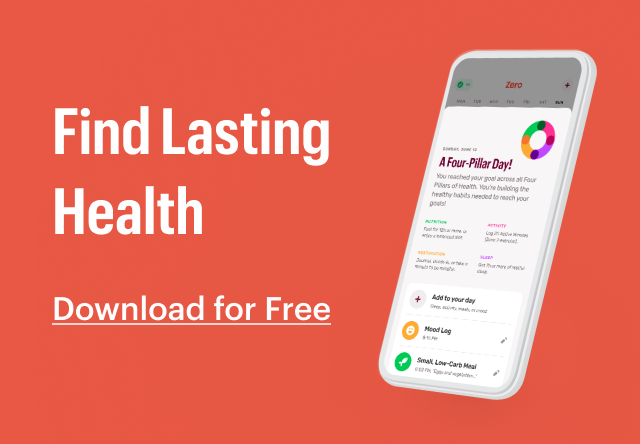Written and medically reviewed by Katya Meyers, RD
Intermittent fasting (IF) is one of the most effective ways to boost health, improve metabolism, and manage weight. Unlike traditional diets, there are no difficult-to-remember rules or macros to count; the focus is on when you eat, not what you eat.
Despite the simplicity, IF often results in a spontaneous reduction in calories and hunger levels as you cue in to your body’s natural signals. In other words, sticking to a shorter eating window, in and of itself, can help you lose weight and burn fat, even without counting calories.
However, you may still be wondering: How many calories should I eat while intermittent fasting? And is there a limit? This article will answer those questions by explaining the best way to meet your IF targets and unlock the many health benefits of intermittent fasting.

How Many Calories Should I Eat While Intermittent Fasting?
The first rule about intermittent-fasting calories is that there are no rules — or at least no hard rules. That’s because extending your fasting window to 12–18 hours each day will typically help you eat less without trying. For example, a common intermittent-fasting plan is 16:8, which means you are fasting for 16 hours per day, and eating within an 8-hour window. This eating pattern also allows your body to shift into Fat-Burning Mode — in other words, using stored fat for energy instead of the food you just ate.
If you are wondering what fasting plan is right for you or how to prepare for your first fast, The Zero app can help. If your goal is weight loss, slowing down to eat mindfully and filling your plate with wholesome, minimally processed foods during a shorter eating window can help further accelerate your weight-loss progress, even when you are not focusing on an exact caloric count. If you’d like to identify an estimated calorie range that will assist in your weight-loss and weight-maintenance efforts, you can do this by performing the calculations described below.
First, however, a few important caveats:
- There’s no “one” caloric quantity that works for everyone who is intermittent fasting. Caloric intake needs can vary by individual and, even within individuals, needs may change day to day based on things like activity level and changes in body composition.
- Both the input (how many calories you consume) and the output (how many calories your body uses) are incredibly difficult to calculate precisely. Therefore, tuning in to your biological hunger cues is an especially useful habit!
- Traditional calorie-restricted diets are notoriously hard to follow. Research suggests failure rates of over 80% within the first year. This is why so many people have turned to fasting for weight-loss results; consistently condensing your eating window is a lifestyle modification that has seen much greater adherence — and results.
- Even when you do manage to maintain the caloric deficit required for weight loss, there is good evidence that your body will quickly lower its energy requirements in order to maintain its initial weight, a model known as “set point theory.” It’s not that your body doesn’t want you to fit into your skinny jeans, per se; for millennia, our species was better served by mechanisms that helped us maintain weight, not lose it. At least until recently.
- Decreasing your daily calorie intake too severely can lead to a deficit of essential nutrients your body needs to maintain overall health and well-being. Drastic reductions also raise the risk of losing valuable metabolism-boosting muscle, which can ultimately stall your weight-loss journey. Fewer calories is not always the right approach.
In light of these important caveats, having a calorie target can be beneficial, especially if you’re new to fasting or your weight-loss progress has stalled. Just remember, consistency — not perfection — is the most important aspect of lifestyle changes like intermittent fasting. Over time, increasing your fast length to more than 12 hours by eating breakfast a little later or dinner a little earlier (or a bit of both!) is likely to yield the results you want. ’
Estimating Your Basal Metabolic Rate (BMR)
Basal metabolic rate, or BMR, is the number of calories your body uses while at rest to sustain basic life functions like breathing, digesting food, and pumping blood through the body. Believe it or not, even “doing nothing” requires a lot of energy and, for all but the most active among us, comprises the majority of our caloric needs each day. However, not everyone’s BMR is the same; factors that influence BMR include age, sex, height, weight, and muscle mass.
BMR is calculated using either direct or indirect calorimetry. To measure BMR directly, the heat your body produces at rest is measured and used to calculate your body’s energy expenditure. However, measuring BMR directly is both a cumbersome and expensive endeavor and is therefore generally reserved for well-funded scientific experiments and select clinical settings. Indirect calorimetry is the more commonly used method to determine BMR. It can be performed using a device to calculate the exchange of oxygen and carbon dioxide in the body.
Even more often, BMR is indirectly calculated using validated equations, such as the Harris-Benedict equation:
- Men
- BMR = (13.75 × body weight in kg) + (5.003 × height in cm) − (6.755 × age in years) + 66.47
- Women
- BMR = (9.563 × body weight in kg) + (1.850 × height in cm) − (4.676 × age in years) + 655.1
Using the original Harris-Benedict equation, a 45-year-old female who is 132 lbs (60 kg) and 5’5” (165 cm) would have a BMR of approximately 1,323.
Calculating your BMR gives you a rough estimate of how much energy your body uses at a base level — if you were to spend all day on complete bed rest, for example. To get a more accurate picture of your energy needs, factoring in your activity level to get your Total Daily Energy Expenditure (TDEE) can help you estimate how many calories you burn daily.
Applying the Total Daily Expenditure (TDEE) Calculation
Your TDEE adds the calories you burn during everything you get up to in a day — jumping out of bed, walking to the shower, taking a walk, lifting your child, etc. — to your BMR. In essence, this number is calculated by summing up all the energy you need to carry out your daily activities and exercise, plus your BMR.
TDEE is found by multiplying your BMR by 1.2–1.9, depending on your activity level. Here’s how to decide the most accurate multiplier for you:
- If you don’t exercise regularly, multiply your BMR by 1.2.
- If you exercise 1–3 days per week, multiply your BMR by 1.375.
- If you exercise 3–5 days per week, multiply your BMR by 1.55.
- If you exercise 6–7 days per week, multiply your BMR by 1.725.
- If you exercise every day, have a physical job, or vigorously exercise twice a day, multiply your BMR by 1.9
Here’s an example, to help you put this into practice: If the woman with a BMR of 1,323 exercises 2–3 times a week, the TDEE is calculated as 1,323 × 1.375, or 1,819 calories per day, which is her estimated intermittent-fasting calorie target for weight maintenance.
Calculating Your Baseline Calorie Needs
Combining your BMR with the TDEE can yield an approximation of how many calories your body needs to get through the day. However, depending on your current weight and health goals — particularly whether you want to lose, gain, or maintain weight — you may need more or less than this number.
Understanding Calorie Maintenance, Surplus, and Deficit
At a basic level, consuming more calories than you expend will lead to weight gain, while the reverse is true for weight loss. One pound of stored fat is approximately equal to 3,500 calories, so a deficit of 500 calories per day should yield about a pound of weight loss over the course of a week for the average person. In theory.
However, there is mounting evidence that the “calories in, calories out” model is more complex than we once believed. For example, a diet high in ultra-processed foods — things like packaged chips, cookies, muffins, and sodas — has been shown to lead to weight gain even when calories are equal. Furthermore, round-the-clock eating or late-night eating that is misaligned with the natural circadian rhythm of the human body can create hormonal changes, like insulin resistance, that can cause your body to more readily store fat.
Finally, there is good evidence that our bodies use BMR as a means of adjusting our caloric needs to match input in an attempt to stave off weight loss. In other words, if weight loss and long-term maintenance are your goals, you may need to look beyond calorie-restricted diets to lifestyle changes, like IF, which can promote sustainable weight loss.
Typical Calorie Ranges for Intermittent Fasting
There are no hard-and-fast rules for how many calories you should consume during your fasts. As mentioned, factors like age, weight, activity levels, gender, can determine how much you should consume. Using the equations above may help to provide an estimate.
But, if you’re wondering what’s “typical,” the USDA recommends 1,600–2,200 calories per day for females 21 and over. For men, an intake of 2,200–3,000 may be appropriate. Remember, these are only estimates, and your individual needs may vary. These ranges are for weight maintenance, so to lose weight or gain weight, you will want to adjust the range up or down by 200–500 calories per day.
Factors That Influence Your Intermittent-Fasting Calorie Limit
Whatever your focus for IF is — weight loss, improved body composition, or something else — fasting can be tailored to meet these targets by taking advantage of the following influences on your calorie intake.
Basal Metabolic Rate (BMR)
As discussed, BMR is the amount of calories your body needs to carry out basic tasks like breathing. With the calculations above, you can determine the minimum quantity of calories your body needs to function.
Activity Level
Increasing your activity level through intentional exercise, such as hitting the gym or running, is one way to increase your TDEE. But you don’t need a gym membership or spandex to increase your caloric needs. Even small “exercise snacks” — like a few laps up and down the stairs at work or an increase in daily activities, such as vacuuming or planting a garden — can boost your metabolism.
Body Composition and Muscle Mass
Because muscles burn more calories at rest, people with greater muscle mass need more calories to manage baseline physiological functions. If your goal is to lose weight via IF, increasing your muscle mass could be the answer, thanks to a higher BMR.
The Impact of Intermittent Fasting on Calorie Consumption and Weight Management
IF provides a simple means of weight management. Increasing your fast length to 12–18 hours — and thereby condensing your eating window to 6–12 hours — has been associated with reduced hunger levels, better insulin sensitivity, and enhanced fat burning. This simple change in when you eat also helps stabilize blood-sugar levels, leading to fewer sugar cravings and more stable energy levels.
At the same time, IF typically results in spontaneous calorie restriction; in other words, by simply sticking to your prescribed eating window, you will unconsciously reduce the amount of calories you eat in a day. This may be especially true if you focus on an earlier eating window — i.e., eating an earlier dinner and foregoing late-night drinks and snacks. In one study of 16:8 intermittent fasting, participants who ended their eating window at 4 p.m. experienced lower hunger-scale ratings, increased weight loss, and improved glucose control versus the control group.
IF also encourages mindfulness in how your body feels hunger and fullness, helping to cut down on distracted and emotional eating. By prioritizing nutrient-dense meals during intermittent fasting, your weight is naturally maintained in a sustainable way.
Setting Goals and Monitoring Progress
There are many ways to measure how intermittent fasting is helping you make progress towards your health goals. If weight loss is your goal, weighing yourself 1–2 times per week at the same time of day (ideally in the morning, after using the bathroom) is one way to monitor progress. Logging your food along with hunger and energy ratings in the Zero app provides another check-in.
But not every person’s goal is about weight loss. Body recomposition — or gaining muscle while losing fat — can yield major improvements in health, even if you don’t want to lose weight. Improvements in blood biomarkers, such as lipid panel, cholesterol, and blood glucose levels provide additional insight into how your body is responding to IF.
Establishing Realistic Weight-Management Goals
Your intermittent fasting journey can benefit from long-range goals and realistic targets. This means avoiding an overly restrictive diet to achieve goals in record time, and instead taking the long view. Instead of focusing solely on weight, target other health benefits, like raised mood levels, better fitness, and improved blood control.
Tracking Progress with the Zero App
Setting goals is great, but keeping track of how well you’re doing to achieve them is even better. You can keep track of your progress and any changes you observe using Zero.
Managing Intermittent-Fasting Calories
Plan Your Meals and Practice Mindful Eating
Did you know your fasting practice can be combined with your preferred diet plan to provide additional health-boosting benefits? For instance, a low-carb diet can enhance the fat burning you’ll experience in the fasted state, while plant-based diets have known benefits for improving cholesterol and lipid blood markers as well as enhancing heart function. Paleo, Mediterranean, vegan, keto, and just about every other diet pairs well with an intermittent-fasting practice.
Even intuitive eating pairs well with IF! Slowing down when you eat and practicing other mindful eating techniques can help provide a sense of control, reduce stress levels, and increase dietary satisfaction.
Choose Nutrient-Dense vs. Calorie-Dense Foods
Nutrient-dense foods give your body balanced nutrition, help manage weight, and improve health. While calorie-rich foods can be enjoyed now and again, these foods can cause setbacks in reaching your IF goals when enjoyed too frequently. Reach for minimally processed fruits, vegetables, whole grains, lean meats, beans, nuts, and other foods that can be grown, raised, or gathered for the bulk of your nutrition needs.
Focus on a Balanced Distribution of Macronutrients
Your body needs three core elements to survive: carbohydrates, proteins, and fat. These elements are called macros and are an essential part of what makes the IF process successful.
According to the International Society of Sports Nutrition, your diet should feature a healthy mix of 45–65% carbohydrates, 20–30% fats, and 20–35% proteins. These values may differ according to your age, gender, active levels, and health goals.
Prioritize Protein-Rich Foods
There are no “good” or “bad” nutrients, but protein has a lot going for it when it comes to weight and fat loss. That’s because this nutrient keeps you full, supports muscle recovery, and can regulate blood sugar levels. Enjoy protein-dense foods like eggs, Greek yogurt, and lean meats during your eating windows for best results. Aim for 1 gram of protein per pound of ideal body weight to support your IF goals.
Common Mistakes to Avoid
Progress, not perfection, is the target when it comes to any lifestyle change, and intermittent fasting is no different. Occasional splurges are totally fine! However, if you are fasting regularly but still not losing weight, one of these may be the culprit.
Eating Too Many or Too Few Calories
During IF, balance is vital for calorie consumption. Eating too many calories may stimulate weight gain, but restricting your eating too drastically can cause a weight plateau or a nutrient deficit that negatively impacts your health. Try to avoid leaning too far in either direction.
Ignoring the Quality of Calories Consumed
While there are no strict off-limits foods with IF, it is possible to sabotage your weight loss journey with too many high-calorie foods that are low in nutrients, especially ultra-processed foods, which are low in fiber and protein but high in sugar and/or fat. Ultra-processed food is often referred to as “junk food” — things like potato chips, packaged cookies, donuts, and other sweets.
Sugar-sweetened beverages are especially nefarious, as they are minimally satiating but provide large infusions of calories. Instead, fill your plate with nutrient-dense foods that support your goals and boost your health and well-being. Health experts agree that a wide array of colorful fruits and vegetables, quality proteins, and healthy fats should form the cornerstone of your diet.
Neglecting Hydration
Remember to keep a water bottle handy while fasting — because sometimes, when those hunger pangs hit, they’re actually coming from thirst! Water, black coffee, and herbal tea can all be enjoyed inside and outside your eating window to increase satiety, suppress appetite, and promote digestion.
Forgetting to Count Liquid Calories
It’s easy to forget that liquid calories will break a fast and push you further from your goals. To stay on track, plain water, black coffee, and sugar-free drinks are ideal choices during both your fasts and eating windows.
Failing to Reassess Caloric Needs as Your Weight Changes
Weight loss may be achieved through a calorie deficit, but as your body adapts to new calorie levels and its new (smaller) size, your energy needs also drop. Therefore, you’ll want to periodically assess any changing nutrient requirements as your body and weight change throughout your fasting journey.
Fortunately, when you choose intermittent fasting as part of your daily routine, you can stop counting calories as a means of losing weight and burning fat. IF is a proven strategy for losing and maintaining weight, improving your metabolic health, and living a longer, healthier life.
Ready to start using Zero? Take the quiz or download the app today.
- The Fasting Guide to Menopause, Perimenopause, and Postmenopause - April 8, 2024
- Try This Instead of That: How to Bookend Your Fasts - March 25, 2024
- 60 Names for Sugar: The Myths, The Facts, and What You Should Know - February 12, 2024






